















S
FRONT PAGE:
Friends of the Botanic Gardens, Cairns ‘Gardeneers’ at the Carnival on Collins plant sale, from left: Val, James and William.
BACK PAGE:
Feathered-horned beetle captured at Cattana Wetlands.
In this issue:
• From the Editor..................2
• Vale long-term Friends of Botanic Gardens volunteers...........................3
• The Green Space Carnival on Collins festivities.........................4-5
• Volunteer Snapshot......6-8
• Engaging the Little Ones Little Taccas & Little Sprouts ..............................9
• Sugarworld Trees............10
• Gardeneers - a dedicated bunch................................10
• Celebrating 25 years of jazz in the Gardens.........11
• Cairns Botanic Gardens 1932 ...........................12-13
• The eyes have itspiders...............................14
• “Defender of Forests” book review ....................15
• Volunteer comment.......15
• Did you know?................16
• Bird adaptations to life in a wetland .................16-17
• Feathered Friends..........17
• Small Wonders................18
• Consider Cockroaches..19
Editor - Volunteers Team Leader, Louisa Grandy
Proof readers - volunteers Sandy Long, Jenn Muir
Contributors - volunteers Val Schier, Janice Pichon, Jennifer H Muir, John Peter, Barry Muir , Bridgette Gower and Dr David Rentz AM

Welcome,
As a part of the Carnival on Collins festivities, we opened the gates to The Green Space education food garden and organised free workshops to engage our visitors - painting, coconut frond weaving and origami. Harp and flute music drifted through the park, creating an enchanting relaxed atmosphere. We received encouraging feedback:

“It was a fabulous time on Sunday. Thanks ever so much Louisa and to all who put the day together” - Catherine.
“The harp music was incredibly moving - I can’t put into words how it made me feel.” - Sandy

The Friends of the Botanic Gardens, Cairns celebrated 25 years of delivering the Jazz Under the Stars event at the Cairns Botanic Gardens (page 11).
On the Sunday, the Gardeneers held their annual plant sale at the Carnival on Collins. This is a dedicated group of volunteers who work tirelessly to propagate and sell plants each Wednesday. See Page 10 for the new location of their weekly trolley sale.
Check out pages 6 to 9, you might see yourself amongst the many wonderful volunteers in the Green Space Our Place program. Thank you for your ongoing support.



In July we were saddened to hear of the passing of two long-standing Friends of the Botanic Gardens, Cairns, Mary Gandini and Norma Wright.
Mary attended the meeting called in 1989 to bring together people interested in the Botanic Gardens and was elected the inaugural President of the group which became incorporated as the Friends of the Botanic Gardens, Cairns. She led the organisation at a time when Jazz Under the Stars and the Spring Fair – later to become Carnival on Collins - were initiated. Mary was a foundation member of the Gardeneers, the group of Friends who propagate plants and sell them to raise funds, and she worked with them for nearly three decades. Mary has left a true legacy.
Norma joined the Friends in the early 2000s. She was a wealth of knowledge and provided Garden tours on a weekly basis, assisted with various events (cooking up a storm for the monthly presentations), engaging and informing visitors in the Friends Shop and supporting the Gardeneers. Norma was also one of the two founding members of what is now known as the Down ‘n’ Dirty volunteers with Green Space Our Place. We will miss Mary and Norma greatly. Our sympathies go out to their families and friends.

















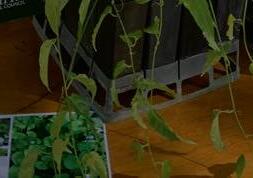

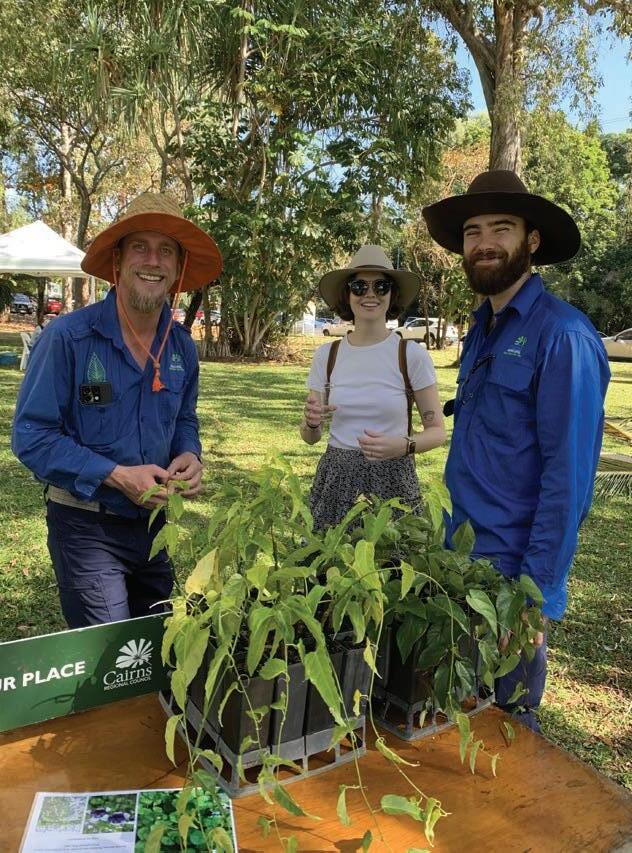










“The harp music was incredibly moving - I cannot put into words how it made me feel.”









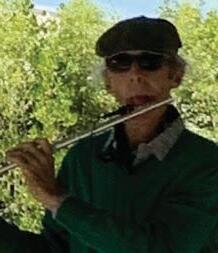




















for sharing your knowledge.





















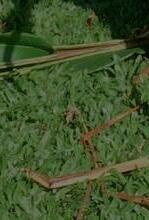

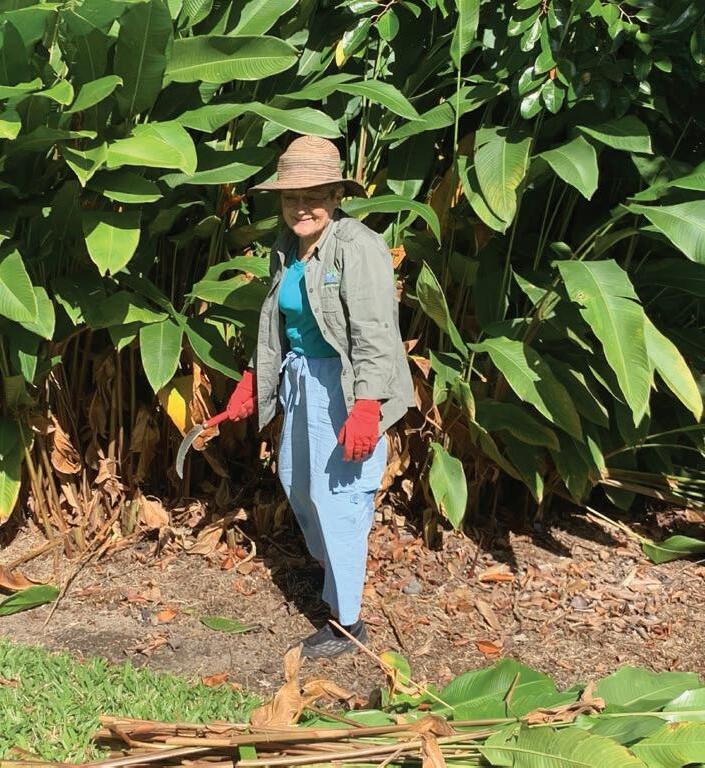












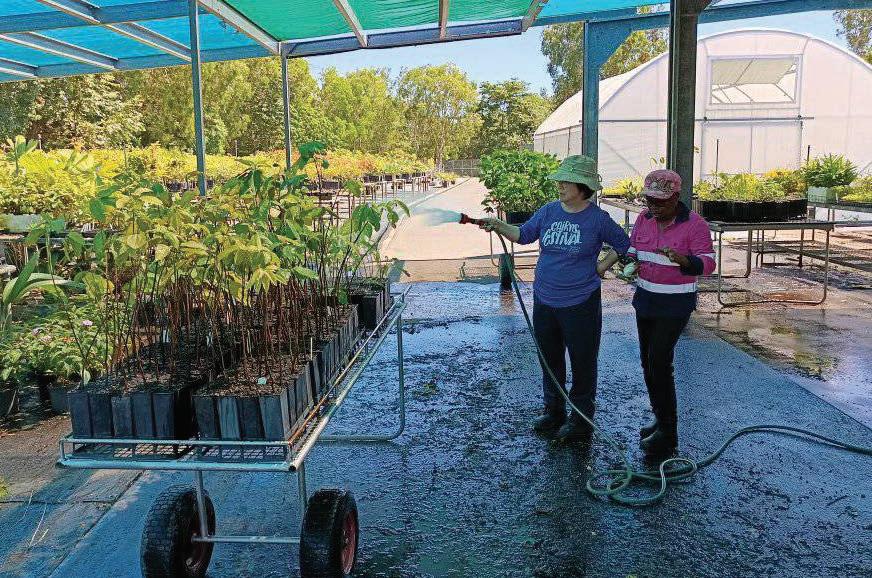








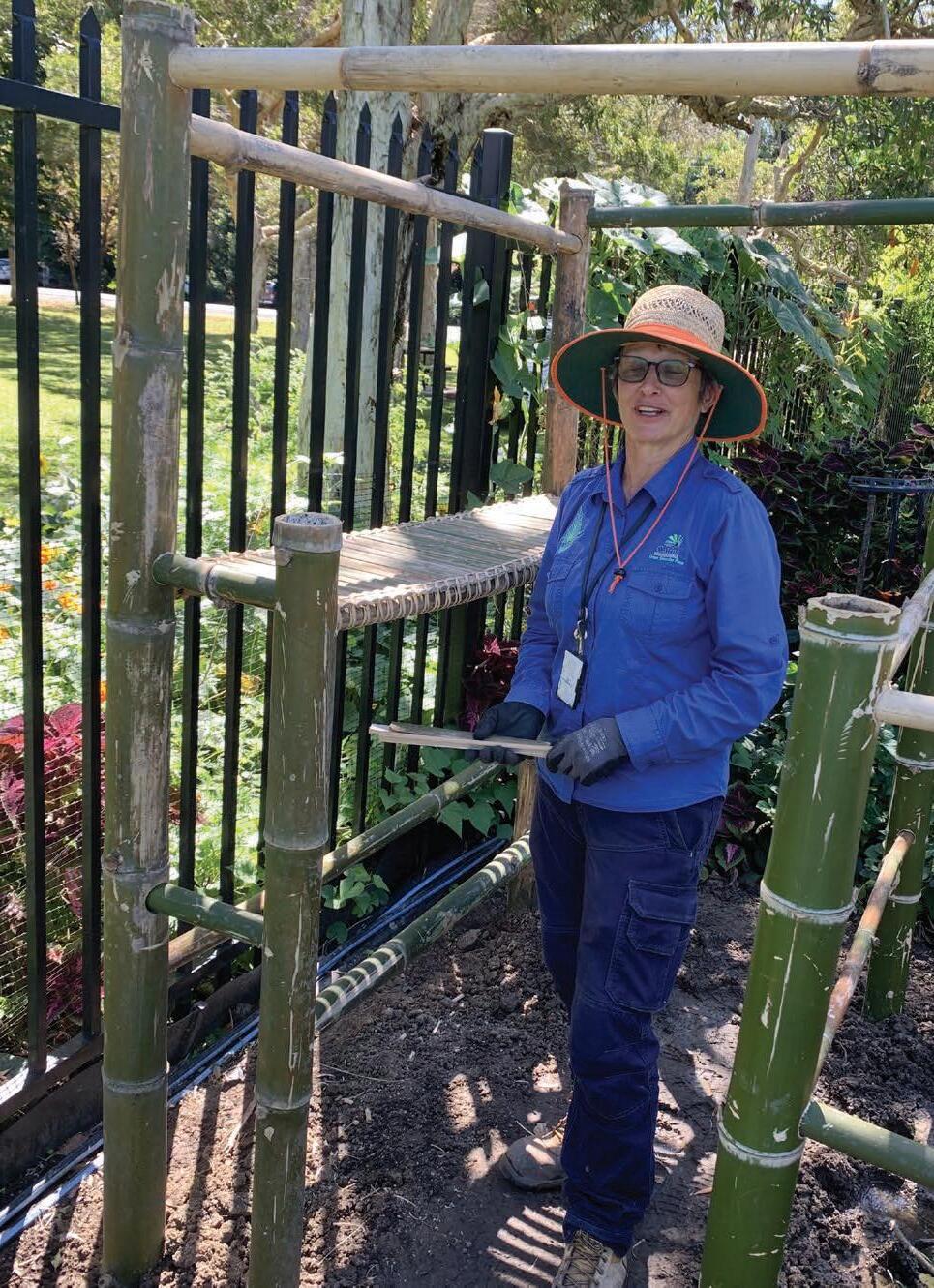
been using traditional methods



Council distributed mulch piles throughout the Forest Gardens gardens last month and the Duck Pond ‘Duckies’ spread every bit of it! Well done to this small enthusiastic group of locals.

Egrets weeding at Russell St - our inner city revegetation site (above and right).


Volunteering has double the benefits - volunteers make a difference to their park and build friendships over a well-deserved cuppa.




Volunteers and Little Taccas explore the Gardens after storytime.


The Little Taccas love our volunteers and we couldn’t run this children’s nature program without them.

A group of dedicated Stratford residents volunteer their time on the last Sunday of each month at Jalarra Park to weed and reveg the seasonal creek.



Little children’sTaccas nature activities program












FRAN LINDSAY
President Friends of Sugarworld Botanic Gardens

Kepel fruit is a tropical tree that is a rare and endangered member of the Annonaceae family, originating in southeast Asia, and closely related to soursop, paw-paw and ylang ylang.
Kepel fruits are aromatic and have a sweet, fruity and tropical flavour.
The fruit is borne on the trunk of the tree and takes a while to ripen. The fruit is ready to harvest when it becomes orange beneath the skin. Unripe fruits are sour and unpalatable and it should be consumed only when ripens over a period of six months. When ripe, the fruit should be rolled between the palms to soften the flesh, sliced in half, and scooped with a spoon.
The tree grows up to 20m tall, with a straight trunk, brilliant bright pink leaves that flush all at once over the entire tree (see picture). The Kepel tree is considered to be one of the most beautiful of all tropical ornamental/fruit trees. Kepel fruit trees grow in a hot, humid climate and are slow growing, taking over 8 to 10 years to fruit. It is propagated from seed, which typically germinate quickly, but can take up to 12 months to develop the seedling shoot. It is being cultivated now in Indonesia for its possible use in the perfume industry. It was once used as a way of giving fragrance to bodily excretions and is said to make urine, sweat and breath, smell of violets.
There are two trees at Sugarworld Gardens behind the Lions Clubs bench seat.
At the Carnival on Collins plant sale, Friends treasurer William (centre) assisted the Gardeneers, from


The Gardeneers are a tireless and dedicated bunch of Friends members, meeting each Wednesday to propagate and sell plants at their trolley sale (see new location below) and conduct three major plant sales, Pre-Easter Sale, Carnival on Collins and the Christmas Plant Sale. They supply a large variety of tropical plants at each sale. Keep an eye on their Facebook page for plant information and sales.
8.30-11.30am
Saltwater Lake Gardens
Look for the green flag sign on Greenslopes St


The weather has been changeable and unseasonal all year, but it performed brilliantly for Jazz Under the Stars 25th anniversary event, organised by Friends of the Botanic Gardens, Cairns.
The Cairns Jazz Club devised a program which included the ever-popular Bernie's Jazz Band, Captain Jazz and the Bandicoots, Kanela and Celestino. The haunting sound of the flute on a still, clear night was quite beautiful.
Several Friends' committee members, who had assisted with JUTS, caught some sleep and fronted up next morning for the annual plant sale, part of
Val Schier
the Carnival on Collins activities. The general public continued to show its support for the Friends, purchasing plants and seeking advice from our Gardeneers with questions such as, Where shall I plant it? Shade or sun? How big will it grow? What time of the year will it flower?
The weekend events raised over $14,000 which will top up our bank accounts and enable projects to be implemented to enhance the Botanic Gardens. Big thanks go to Council staff who helped with setting up and dismantling both events, and to the Friends' volunteers. A special commendation to committee member Sue, who pulled together Jazz Under the Stars.



The Cairns Botanic Gardens first came into existence in the late 1880s, a decade after pioneering European settlers established the township of Cairns. Throughout their history, the Gardens have had a staggered development at the mercy of civic desire, economic support and curatorial direction. The following extract from the Northern Affairs newspaper paints an insightful picture of the situation at the Gardens in May 1932*:
When visitors come to Cairns, they come to what they believe to be a tropical city. They expect to find that the city authorities are eager to apply themselves assembling botanical specimens for the adornment of the city. A definite advance in this regard has certainly been made during the past four or five years, and the streets have returned many-fold in beauty…as the tropical plants and trees there are expanding …
But there is another direction in which this beautification principle might be followed. It is a proposition that does not appear to be embraced in the schedule of works drawn up by the City Council. Yet it is one that would not only benefit Cairns but would bring it into line with other cities throughout the country - the establishment of botanic gardens.
The purpose of the nursery at Edge Hill [Edge Hill Nursery] at present is merely propagation of plants and shrubs to supply the city garden plots and enclosures. But apart altogether from the parks, there should have been a botanical garden long ago for the pleasure, instruction and attracting of tourist and resident alike. Such a garden could not spring up mushroom like overnight and consequently any time is the right time to make a start.
In the years gone by there was a wonderful collection of plants at Kamerunga [Kamerunga State Nursery], and the information obtained there was of great value. Viewed now in light of what is needed to interest the visitor, its being allowed to go out of existence was a calamity …
During almost the same period the botanical reserve at Edge Hill was also in existence and the gardens [Fitzalan’s Original Botanic Garden] there were of considerable note. A few lone trees – the “rain tree” for instance – survived the abandonment of the garden and have now acquired a grandeur of development that seems to invite the civic authorities to beautify the reserve in their vicinity …
Edge Hill is the gazetted botanical reserve and is admirably adapted to the making of one of the finest gardens in the Commonwealth. Soil and setting with their hill side slopes and numbers of rivulets, surrounded by a glorious jungle, have already provided an initial
panoramic environment of natural beauty. The extensive patch of nearby scrub, rich with its profusion of swamp palms and tropical vegetation, is the only virgin belt that remains in the city area. It offers as a consequence advantages not obtainable elsewhere for a natural and boundless botanical reserve …

Janice Pichon
It would take perhaps a considerable time to develop, as we have said, but it will take longer still if no start is made. Nobody doubts that such a garden is needed, and even demanded, at such future time. The question might reasonably be asked then: What are we doing today towards bringing it into being?
This article highlights important stages in the development of the Gardens. Fitzalan’s Original Botanic Garden was located on gazetted land on the southern side of Collins Avenue opposite the Tanks. It was developed by Eugene Fitzalan in the late 1880s. Meanwhile, 10km away, the well laid out rows and plots of experimental plants at the Queensland Government’s Kamerunga State Nursery was an attractive alternative. The Rain Tree mentioned no longer exists but did provide a shady picnic and play area for families for many years.
After Fitzalan’s retirement in 1897, municipal interest in his Garden dwindled. It was eventually abandoned in the early 1900s in favour of less swampy ground on the northern side of Collins Avenue. The area named Fitzalan Gardens today lies to the west of the Original Botanic Garden and was created in the 1970s.
The Edge Hill Nursery was in the western section of today’s Flecker Garden. It was established by Les Wright, the first curator after Fitzalan to make any real progress on a formal botanic garden. Hired in 1923, principally to beautify Cairns, his nursery was a de facto botanic garden, until he began planting an arboretum-style garden in the 1930-1940s. It wasn’t until the curatorship of Vince Winkel from the mid1960s that the Cairns Botanic Gardens took on their present layout.
What foresight was shown by the anonymous contributor who penned this article over 90 years ago! In the following decades, their lofty ambitions have been realised through the development of what is now called Flecker Garden. Even the patch of remnant virgin vegetation pointed out above has been showcased with the installation of the Rainforest Boardwalk. Today, Cairns is indeed proud to have such a valuable and much-admired community and tourism asset.
*Anon. The Cairns Botanical Gardens. Northern Affairs May 6, 1932.
Location of Fitzalan’s Original Botanic Garden.


Kamerunga State Nursery c.1901-12.





Most spiders (about 99%) have eight eyes, and some only have six or four, but their eyesight is very poor, detecting little more than light or shade or change of sudden movement. They mainly use vibration and touch to catch their prey. The middle pair of eyes of some spiders can detect polarised light, useful in hunting, and the daytime active jumping spiders, flower spiders, wolf spiders and net-casting spiders have much better eyesight. In some cases (not all) the eye pattern is characteristic of the spider family.
Examples (right) are the variation in eye patterns of Australian Spider families (Australian Museum):
• The Pholcids are the Daddy-long-legs;
• Araneidae the common Orb-web Spinners, which includes the Communal Spiders with their huge webs containing many spiders living together, and the beautiful little purple and yellow spiny spiders so common in the Botanic Gardens;
• Thomisidae the Crab and Flower Spiders are also common in the Gardens;
• Tetragnathidae are the Long-jawed Spiders, also common;
• Salticidae are the colourful little Jumping Spiders; and the Lycosidae are the hunting Wolf Spiders we see so often by their eye-shine on our night walks.



The eyes of most spiders are typically in two rows, right at the front of the ‘head’. The largest eyes are different in structure to the other eyes, being darker, whereas the other eyes usually are paler and have a layer of light reflecting crystals called a tapetum, giving these eyes a silvery appearance. The tapetum increases sensitivity because light entering the retinal cells is immediately reflected back through them, so intensifying the image. Cats, foxes, crocodiles and even humans also have a tapetum. That is why we get red-eye with flash photographs and why we can find wolf spiders so easily on our night walks by looking for eye-shine. Thus, although spider eye lenses are better than photographic lenses in terms of their image brightness, their retinas have very coarsegrained receptor cells, so resolution is poor.
In some net-casting spiders, which were once fairly common in Flecker Garden, two of the rear eyes have great, curved lenses like twin search lights, giving the spiders the unflattering name of ‘Ogre-faced Spiders’. These huge eyes provide superb night vision, much better than a cat or owl, allowing the spiders to throw their net over their prey with accuracy. Studies have shown these spider eyes manufacture a large light sensitive membrane each night and reabsorb it at dawn. The spider even plans in advance and puts a few spots of white faeces on the leaf below to give it something to aim at with its net!

The jumping spiders are most active during the day and there are dozens of species throughout the Gardens. These spiders are mostly less than 15mm long but can leap more than 20 times their own body length. They have excellent vision which they use to hunt prey and to recognise potential mates and enemies.
The eyes of jumping spiders see in three different ways, using three different sets of eyes. The spider first senses movement of distant prey with the side eyes, which provide a blurry wide-angle image. Once movement is detected, the spider turns in that direction and locks onto the moving prey with the large, middle front eyes. These eyes provide a clear, focussed telephoto image, probably in colour. The spider can track moving prey both by body movements and by using muscles to swivel internally the elongated eye capsules so that the light sensitive retina of each eye remains locked on the prey. While the spider stalks closer, it uses the side front eyes (binocular vision) to judge the distance to the prey. When it judges the prey to be close enough (usually about 2-10cm), the spider leaps.






People were reminded of what a remarkable environmentalist Peter Hitchcock was when they recently attended the launch of Defender of the Forests, the book he was working on at the time of his death, from cancer in 2019.
Former colleagues Lorraine Cairnes and John Benson promised Peter's wife, Liana, that they would finish his book and it is a must-read for anyone interested in Peter's life and the efforts he went to protect the tall eucalypt forests of Australia, New Guinea and Indonesia.
As well, readers can learn of Peter's time with the Forestry Commission of NSW and his stint as the first Executive Director of the Wet Tropics Management Authority, a joint initiative of the Queensland and Australian Governments to coordinate the management of the Wet Tropics World Heritage Area.
There are also chapters on his role of inquiring into the tall eucalypt forests of Tasmania and in evaluating World Heritage sites throughout the world for UNESCO.
The book reveals that Peter was a quiet, unassuming visionary who made extraordinary national and global contributions to forest conservation, rainforest protection, World Heritage and national parks.
Defender of the Forests, published by Steven Nowakowski, is available from book stores in Cairns and will be stocked at the information centre in Friends House.

Ian Northcott
I have moved away from Cairns to be closer to family and I just wanted to tell you how much I enjoyed volunteering at the Garden.
The Green Space was a great place for a unit dweller to be able to escape to. And an important contributor to my mental health, especially over the Covid period.
Thank you so much for making it happen. And also for your friendship over the last few years.
In my previous articles in GSOP Volunteers Voice (September and December 2023; March 2024), I discussed various types of waterbirds, most of which depend on wetlands for survival. Then in June 2024 I wrote about types of wetlands. Now I’m continuing the wetlands theme by looking at how waterbirds have adapted to survive in their wetland habitats.
Life is tough and animals need their own ways to survive in a world of competition for food, water, shelter, nesting sites, etc. So, slowly over a very long time, birds have adapted in various ways to enable each species to survive and reproduce in their environmental niche - in this article, in wetlands.
First, let’s have a look at the darter. In the photo here of a female Australian Darter, you can see how beautifully adapted this species is to life in a wetland. Darters have a ‘need for speed’ so they can chase and catch their prey (mainly fish) underwater. In the photo, you can see the long neck and generally streamlined body shape; with long tail and paddleshaped feet. These adaptations enable darters to swim fast enough to catch fish; most being fast or evasive swimmers that prefer not to be eaten!
Further, darters’ eyes are close behind the bill and facing forward enabling binocular vision, which is directed along the bill, so the birds can effectively triangulate their view directly at their prey, resulting in greater accuracy (see the Little Pied Cormorant photo).
Darters usually spear fish underwater with their sharp, dagger-like bill. They then swim to the surface with the impaled fish, normally tossing it up in the air

If you want to know birds better, a good way is to look closely at them. Binoculars are ideal. You can tell a lot about a bird and how it lives by looking closely at it.
Food is crucial for survival, and many birds have distinctive bill shapes that enable them to get their share in a complex, highly competitive world.
Magpie Geese, for example, have strongly hooked bills used for digging for roots and tubers under the ground or under water when they up-end. Their bills also help them graze or strip grass seeds on terra firma (land).

JENNifEr H
so it falls face-first to the bird which then swallows the fish whole. Sometimes it can take many attempts for the bird to get the fish in the right position for swallowing. Why does it do this, do I hear you ask? Imagine swallowing a whole fish tail-end first: those scales and/or spines could stick into the bird’s throat and cause a few problems.

Female Australasian Darter drying her feathers. Note her streamlined body and paddle-like feet for fast swimming.
Jennifer H Muir
A long bill is better for probing soil or mud on beaches; or in cracks, between rocks, plant roots, etc to find prey that other birds can’t reach as their bills aren’t as long. Shorebirds (waders), such as the Eastern Curlew use their long, probing bills on beach sands and mud for prey such as worms, crustaceans and moluscs.
A long, thin bill can get into nectaries in flowers, and ‘tweezer’-like bills are good for picking up and holding insects – our well-known Sahul (Olivebacked) Sunbird takes nectar from flowers and insects where they can find them, as well as small spiders (Arachnids) for their young.
It’s understood that the physical structure of darter feathers makes the feathers less waterproof. Although this helps in underwater pursuits, the birds can lose body heat while under the surface, so when they leave the water, they have to dry their feathers to maintain a safe body temperature. They’re often seen sunning themselves along rivers and lakes.
Then there are the cormorants that, like darters, have streamlined bodies enabling them to rapidly chase fish underwater. Their bills differ from those of the darter, and this is an obvious identification factor between darters and cormorants. Cormorant bills have a hook at the end of the upper mandible of their bills which enables them to grab the fish.

Australia’s Little Pied Cormorant, a typical cormorant, showing its forward vision, that’s also typical of darters. Note the hook at the end of the bill.
JOHN PETER BirdLife Australia

Like darters, cormorants also have forward-facing eyes close behind their bills, again enabling binocular vision directly down the bill, so the birds can triangulate their view for more successful fishing.
Little Pied Cormorants often dive deep into the water kicking both feet outward in unison, to catch a wide variety of aquatic animals including insects, fish, yabbies (freshwater crayfish) and other crustaceans.
Last, but not least in this article, are the grebes. Grebes are diving birds that primarily eat fish, and their feet differ from those of darters and cormorants: grebes have lobed toes to help them swim. They have a short bill ideal for catching small fish and water insects. Their adaptations enable them to feed on the water surface and in the shallows, but they also dive deep underwater to capture most of their prey.
It’s understood that during breeding, grebes, including the Australasian Grebe, often eat their own feathers and feed them to their young to help prevent injury when swallowing fish bones.


With their enormous beaks, Australian Pelicans are familiar to almost everybody! And they’re easy to see, whether it is along sheltered coasts, such as the Esplanade; in estuaries like the Barron River; or other wetlands, like ponds in the Botanic Gardens.
Pelicans scoop up to 13 litres of water in their beak pouches, then filter it to leave fish and other aquatic animals stranded; they’re swallowed with a backward toss of the head. They sometimes also snatch ducklings and gulls – both young birds and adults – which are swallowed head-first.
Occasionally, pelicans also feed by making shallow dives, beak-first, or forage cooperatively in groups, encircling schools of small fish and scooping them up, all dipping their beaks into the water simultaneously. Other waterbirds, especially cormorants, are sometimes mugged by pelicans, stealing their catch.
The pelican’s pouch is also a vital tool for keeping it cool in hot weather: they vibrate their pouch, which acts as an air conditioner, transferring heat from their body. The same rippling action is also used as part of their courtship display. However, the enormous bill is not the longest feature — the wings are. They are perfect for gliding on updrafts, and by circling round in columns of rising air. Pelicans can reach altitudes of several kilometres. In this way they can cover enormous distances, so the pelicans you see around Cairns may well have flown there from coastal Victoria, the deserts of South Australia or even Perth!

Barry Muir




Bridgette gower
The Tar Tree (Semecarpus australiensis) is closely related to the Cashew Nut. All plant parts and the sap of the Tar Tree are highly corrosive and can cause blisters on the skin. Even smoke from the burning wood can be dangerous. Aboriginal people covered their hands with clay to avoid contact and then roasted and soaked these strange orange and brown fruit to render them edible. Despite their corrosiveness, Cassowaries eat the fruit without any adverse effects. These trees grow across northern Australia and in Papua-New Guinea.
Mantis Flies (Mantispidae) are strange creatures. They have wings like a damselfly but grasping front legs like a praying mantis. They are closely related to ant-lions - the little guys that build cone-shaped ant trap pits in sandy soil. The adult Mantis Flies grab prey with their front legs like praying mantises, but their young feed on the egg sacs and eggs of spiders or the larvae of social wasps.
Marasmius haematocephalus ranges from magenta to red or brown in colour but the various colours may prove to be different species. This is currently being investigated. Caps are from 5–12mm in diameter on long, thin black stalks. There are only a few gills, and the cap is grooved above where the gills are located. They grow on twigs, leaves and branches in wet areas and often appear along Collins Avenue next to the footpath.
dr daVid reNtZ aM
Cockroaches in the kitchen or restaurant should not be tolerated, but consider the role they play in nature. Our native species are ‘generalists’ or ‘opportunists’ (better than calling them scavengers). They feed on a variety of plant material. One of their important ‘side effects’ is that they pollinate many kinds of plants. They do this, like bees and wasps, by walking over the flowers and moving pollen around on their bodies while they are feeding. They eat some of the pollen as well as other floral parts like the anthers and petals. Pollen gets caught on the hairs of their bodies and when they visit the next flower, pollen can potentially be transferred.

Carbrunneria paramaxi feeding on Hibiscus pollen at night.


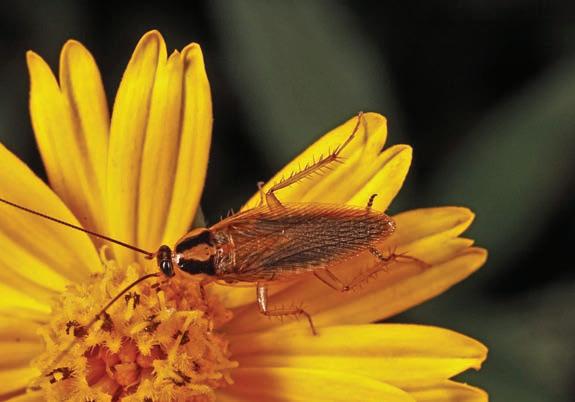


Friends of the Botanic Gardens, Cairns
Membership details email - phone 4032 3900 or email info@botanicfriendscairns.org.au
After joining you can support the Friends in many ways; as a committee member, in the Friends Shop, as a tour guide or assisting with events.
Friends of Sugarworld Botanic Gardens
Contact Fran Lindsay frantastic10@bigpond.com
Magazine Contributions:
Please submit articles (must be volunteer or nature based) by first week of November for the next quarterly publication in December.
Email: l.grandy@cairns.qld.gov.au
Please note articles are subject to editing. Like us on Facebook to keep up to date with all events or visit our websites:
- Green Space Our Place
- Cairns Botanic Gardens
- Friends of the Botanic Gardens, Cairns
• Mondays - Russell St Environmental Park Egrets 9am-noon
• Tuesdays - Cattana Wetlands Jabirus 9am-noon
• Wednesdays - Botanic Gardens Down ’n’ Dirty volunteers 9am-noon
• Wednesdays - Tracks ‘n’ Trails 9am-noon
• Thursdays - Stratford Nursery 9am-noon
• Thursday (once a month) - Sugarworld Friends & Gardeners
• Fortnightly Thursdays - Children’s Nature Activities Program - Little Taccas / Little Sprouts
• Heritage Tour Guides - Thursday 10am from the Botanic Gardens Visitor Centre
• The Green Space education food garden - Wednesdays / Fridays
Interested in becoming involved with your local park, reserve or tracks in your community? Contact us to register as a Council volunteer and be involved in beautifying your park (enhance planting, weed management, litter clean-up), reporting on issues (graffiti and vandalism, anti-social behaviour, maintenance issues) and building community participation (networking activities) with Council support.
If you are interested in supporting any of our weekly groups or volunteering in your local area contact Volunteers Supervisor Louisa Grandy 4032 6648 or email greenspaceourplace@cairns.qld.gov.au
